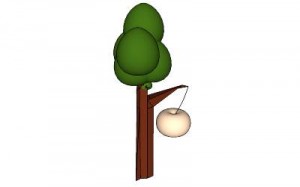Fruit trees are really, really inefficient.
In order to reproduce, they wrap their seeds in delicious, juicy fruit. This will hopefully entice birds and animals to eat the fruit, thereby picking up the seed and moving it. This will transport the seed to a far off land, where it will be deposited in the ground when the animal poops it out. In that place, the seed will grow into a big, healthy tree. Reproductive success!
But that isn’t what happens to most of the seeds. Much of the fruit drops straight to the ground and is never eaten. It rots in the shade of the parent tree, and so the seed does not grow into a tree. Only a small fraction of the fruit that the tree creates ever grows into a new fruit tree.
Enter the CEO. The CEO looks at the balance sheet. Under expenditures, it sees a great deal of energy that is spent on making hundreds and hundreds of fruit. Under revenue (or, I suppose, more accurately, assets gained… or perhaps dividends… I’m not really sure which one works the best as a metaphor), there are maybe a dozen new trees that actually are created. That’s not a very good balance sheet. Things could be much more efficient.
“If we are smart and efficient,” says the CEO, “We can cut down on the fruit-related expenses. This will allow us to have more energy left over for other things, like growing bigger and stronger branches, a thicker protective bark, or more leaves. This tree will thrive and be more successful if it can only cut back on the number of useless fruits that it creates.”
So the CEO implements a very clever plan, and engineers a fruit tree that spits out only one seed per year. However, through clever genetic manipulation, artificial intelligence, nanotechnology, and other high-tech things, he is able to make it so that the tree directly hurls that single seed to land in exactly the best spot for it to develop into a tree. It is able to take into account hundreds of variables, including moisture, sunlight, the probability of predators or other plants interfering with development, everything. The chances that each seed will actually produce a tree are near 100%.
The CEO plants an orchard of these ultra-efficient trees. These trees are the model of efficiency, and waste no energy. Everybody applauds. The board of directors gives him a bonus.
In the first few years, the fruit trees do very well. In fact, they do much better than regular fruit trees. This is not surprising: they are more energy efficient, and do not waste a single fruit. Every seed they produce becomes a new tree.
But over time, something else happens. The grass around the trees, usually fertilized by rotting fruit, begins to die. The animals that used to graze in the orchard because they ate the delicious fruit all wander away, in search of more yummy places to graze. Without grass as ground cover, the soil begins to erode away and the natural nutrients begin to get depleted. Eventually, nothing is left on the land but the trees, which then start to die as the soil becomes less and less fertile and erodes away to expose the tree roots.
The fruit trees all die, even though they were the epitome of efficiency.
It turns out, the fruit trees were part of a larger system in the orchard. By making the fruit trees more efficient, it broke the links in the energy cycles that connected the trees to the grass and the animals and every other living thing in the orchard. When those links were broken, the system collapsed.
And there is nothing “efficient” about that.


